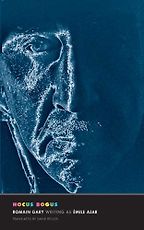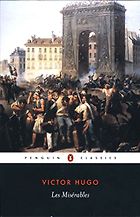Tell me about Victor Hugo’s Les Misérables (1862).
I read Les Misérables when I was a kid and then re-read it last summer and, do you know, I am now convinced that it is the greatest novel of all time. Every story in the world is somewhere in there. It’s extremely sentimental, it’s extremely historical and digressive, there are parts of it that are boring as hell – but that’s true of War and Peace and other great novels. Overall, it’s such a compendious, wonderful thing, full of gems.
Such as?
Oh, the description of the Battle of Waterloo, a love story between Marius and Cosette which is absolutely heart-rending, actions of kindness and grace, wonderful chapters on the Paris underworld of the 1820s… There’s a fantastic chapter near the end where Valjean carries Marius through the sewers which is one amazing horror story.
How was Les Misérables received at the time?
It was an event bigger than the launch of Titanic and Avatar put together. Hugo was a European celebrity and he had an enormous fan base in France both for political and literary reasons. He was a hugely popular writer and a great poet. His wife organised the most tremendous publicity launch – advertisements everywhere, posters, placards, all the newspapers featured it.
Amazing.
Yes, but he wasn’t there to enjoy it. He was in exile on the island of Guernsey from where he could almost see France on a clear day. And one big dimension of Les Misérables is it’s a novel of nostalgia – he’s trying to reconstruct the Paris of his youth which he didn’t know if he would ever see again. In a sense, he never would because most of it had been rebuilt during the Second Empire by the time he got back.
Why was he in exile?
Because he was an opponent of Napoleon III who had seized power in a coup d’état in 1851 and turned what had been a left-wing revolution into a – not vicious – but very authoritarian right-wing regime, and Hugo, who was a leading figure in French politics, objected and the Emperor said ‘Out you go’; many hundreds, thousands, of opposition figures were exiled, imprisoned or executed at that time.
Is it a political novel?
Yes. It’s not directly political because it’s set in an earlier period, about 40 years earlier. It contains lots of essays, digressions about the nature of revolution – when is a crowd a mob? and so forth; there’s a kind of retrospective justification for revolt. More broadly, it’s a novel with a liberal left agenda that would become fairly orthodox by the end of the 19th century – calling for more education, a better deal for the working classes, etc. It shaped the view of what is good and right for several generations to come.
Are the characters believable?
Well, the main character, Jean Valjean, is completely unbelievable but completely fascinating. Unbelievable in the sense that he’s totally sexless, he’s a former convict from the very dregs of society, and yet is a man of extreme cleverness. He is a novelistic hero. Absolutely wonderful, but credible? No!
People relate to the sentimentality, don’t they? I’m thinking of the musical.
Well, because it’s so huge and so capacious and contains so many different stories and takes on the world, you can make anything out of Les Misérables – including Broadway’s longest-running musical. The thing is – and the reason I’m so enthusiastic about it – I realise how many other novels come out of it, how much material it’s given not just to French literature but to world literature, English and Russian as well. We often read books without realising that actually Hugo invented this story. A huge undertow of 20th-century literature is attempting to rewrite Les Misérables.
Let’s move on to La Cousine Bette (1846).
This was written when Balzac was feeling he had not really made the mark he ought to have made and that other people were running away with facile successes. He really needed a kind of counterblast. His politics were the opposite of Hugo’s – he was very suspicious of all these new-fangled ideas about justice; he thought it was quite a good idea to keep people in their place. So, Cousin Bette is a story designed to show you just how awful people are. And, my God, they’re awful! It is one of the most sombre visions of human corruption and perversion, self-indulgence and evil. That’s why I’ve chosen it – it’s a kind of antidote to Victor Hugo.
Is Cousin Bette herself evil?
Yes! She manipulates a young whore, Valérie Marneffe, into seducing and tormenting and ruining the head of a household Bette thinks is treating her unfairly. And she succeeds. The great man, a former general, a baron, ends up destitute and his wife and children are ruined. Bette causes a familial cataclysm that’s also a social cataclysm, out of sheer vindictiveness.
Does she get her comeuppance?
No. Well, she dies, but I think she dies a happy woman.
It’s a very impressive novel and stunningly modern as well. It also has to do with the origins of colonial exploitation – the story of the money is the story of Algeria actually. Balzac had an intuitive understanding of where corruption was to be found, where what was going on was really dirty. And he really pulled out all the stops to give us this portrait of a society that was rotten to the core.
Are there any sympathetic characters at all in Cousin Bette?
Well, curiously, yes, the main figure, the man who is brought down, who is simultaneously corrupt and naive, boorish and charming – he’s vulnerable to this young woman [Valérie Marneffe] and he just can’t resist. Balzac does in the end make you feel quite sorry for a guy who puts everything in jeopardy for a passion he can’t resist. And he doesn’t realise that she’s doing it on purpose.
Do we feel any sympathy for her?
Oh no, I’m afraid not. There isn’t any redeeming feature in Valérie Marneffe, apart from the fact that she’s gorgeous and smart. But no, she’s not nice.
Tell me about Perec and Life: A User’s Manual (La vie mode d’emploi) (1978). Your own translation.
Yes, I did it more than 20 years ago. This is a 20th-century novel which, in its own special way, is as ambitious and as capacious as Les Misérables or the other great encyclopaedic 19th-century fictions. And that’s why it’s unusual, coming out in Paris in the 1970s. It’s not the kind of novel that was made necessary by contemporary ideas of what fiction should be. It really is its own thing – a very special thing. What it is is a completely stationary novel, which seems a contradiction in terms; the entire novel happens in the blink of an eye, just before eight o’clock on 23 June 1975. Each chapter, of which there are 99, describes one room in a block of flats in a particular place in Paris, a fictional place but the surrounds of it are not fictional at all, and so each chapter is the description of a room. And, as he describes the room, he describes the objects in the room, and the objects are attached to narratives about how they came to be there, and so, little by little, in this sort of pointilliste way, the stories build up, because some of the people are connected and some aren’t, and over these 99 chapters you get a sense of the multiplicity of lives, and of an over-arching story – that of a millionaire called Bartlebooth who is so rich he doesn’t know what to do with his life. So he adopts a plan that will keep him busy and harmless for the next 50 years.
“A huge undertow of 20th-century literature is attempting to rewrite Les Misérables.”
For ten years he learns to paint watercolours from a painter who lives in one of the flats and then for 20 years he tours the world, painting one watercolour per fortnight which he sends back to Paris where it’s mounted on a piece of ash board and cut into a cunning jigsaw puzzle by another resident of the flats. At the end of the 20 years Bartlebooth gets back to Paris, having very conveniently missed the Second World War, and settles down to solve his jigsaw puzzles – one a fortnight for 20 years, which will bring him to 1975. But the plan involves a very special process whereby, once he has reassembled the puzzle – a watercolour of a port scene that he vaguely remembers from 20 years before – it can be glued together again and sent back to where it was originally painted. There it is dipped in a detergent solution and returned to being just a sheet of paper. So it all goes round and round in complete perfect circles.
Weird. But isn’t it just a clever conceit?
No. There are hundreds of other stories slotted in like jigsaw puzzle pieces. Some people love it for its cleverness but, behind the cleverness, there is something more, something not as simple as a psychology or a character, but something deeply human, deeply reflective of the human condition. Perec didn’t believe you could really get to know a person better than by looking at the details – what they put on their mantelpiece… He wasn’t at all keen on what Balzac and Hugo do which is to tell you what’s going on inside somebody’s head – he thought you could never know what’s going on inside somebody’s head, but you could deduce it from what they do outside.
What about Raymond Queneau and Les Fleurs Bleues (1965)? Another stylist, isn’t he?
Yes. Queneau is an extremely multiple-gifted, talented writer, poet and essayist, and also a mathematician. Les Fleurs Bleues – Blue on Blue in English – is in the witty comic novel tradition. None of the books I’ve chosen up to now could be called comic. This is comic – wonderfully so. It’s a double story of a guy in retirement, living on a barge on the Seine, and after lunch he always has a sip of pastis and drops off, and the moment he drops off he dreams he’s someone else. And that someone is a medieval nobleman from Normandy who contemplates the historical situation and goes and bashes up a few peasants and has a meal and a drop of essence of fennel and drops off to sleep… and dreams he is a man living on a barge on the Seine, etc. And it goes back and forth, back and forth, between the one dreaming he’s the other, etc, except the historical reference point of each of the dream sequences moves forwards by 176 years each jump – you have to work that out for yourself – and by the last chapter, of course, what we suppose is the dream character, the medieval baron, actually turns up in Paris in 1965 and meets the guy who’s dreaming him and they get thoroughly confused. And the barge pushes off into the Seine and disappears into a bank of extremely murky fog!
OK. Pseudo by Romain Gary/Emile Ajar, or Hocus Bogus (1976) in your translation. This sounds fun too.
Yes. This is comedy taken to the point of complete lunacy. Or vice versa. Hocus Bogus is the use of fiction to achieve quite improper ends – being to persuade the world for all time that the author was not what he seemed. To put it in context, Gary was a popular and very gifted novelist who’d gone out of fashion in the 1970s. He’d already won the Goncourt Prize and was an international celebrity in all sorts of ways, but he belonged to the old crowd and he didn’t like that. So he started publishing under another name, Emile Ajar, and this was very, very successful. Lo and behold, he went and won the Goncourt Prize a second time, as Emile Ajar! The hoax was kept completely secret and he really did pull the wool over the eyes of the entire literary establishment of Paris. But he sort of got too involved with his own deception once he’d won the Goncourt Prize again – which wasn’t allowed – and he got paranoid about being found out. So he wrote this book in which he pretended to be somebody else confessing to being Emile Ajar. And that somebody was mad.
The purpose of the book was to make it absolutely clear that Romain Gary was not Emile Ajar and that Emile Ajar was Paul Pawlovitch, a real person in on the hoax, and that Paul Pawlovitch was loony. And it worked! It was perfect. It deflected suspicion from Romain Gary for the rest of his life. It propelled him into a sort of total outer space, because he was Emile Ajar and nobody knew it. He could write anything under the name Emile Ajar – he could even rewrite one of his own books under the name Emile Ajar.
So it’s the use of fiction and fantasy and comedy to achieve ends that lie outside of literature. But, at the same time, under those layers and layers of cover, it enables Romain Gary to speak about himself in a way he had never been able to before.
It must have been difficult to translate.
Well, all translation is difficult! But, because it is written by a madman who has difficulty with language and whose language keeps getting out of control, it is full of puns and allusions and crazy bits, which, in my view, licenses the translator to invent his own puns, to let the English language do crazy loops and somersaults that Gary does in French.
Can you give me an example?
No, I’m too modest. Well, I’ll just say there are some puns that have made some people laugh.
Five Books aims to keep its book recommendations and interviews up to date. If you are the interviewee and would like to update your choice of books (or even just what you say about them) please email us at [email protected]
Five Books interviews are expensive to produce. If you've enjoyed this interview, please support us by donating a small amount.












